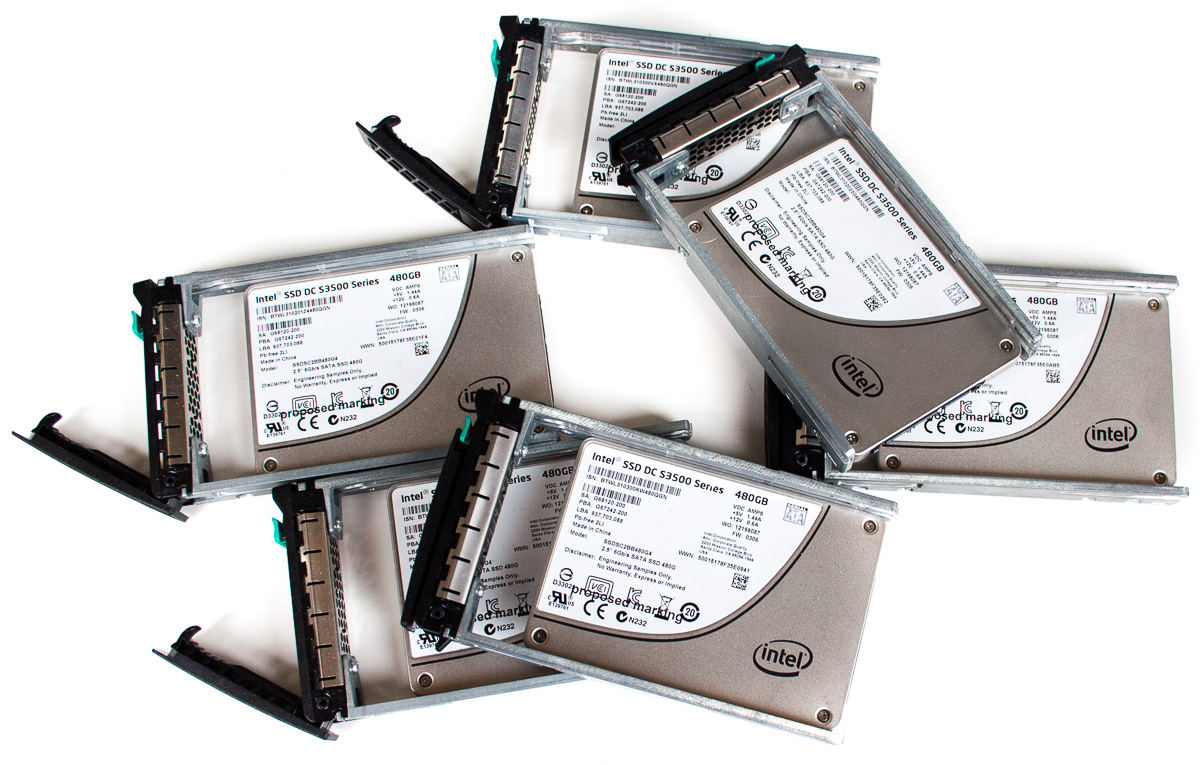Six SSD DC S3500 Drives And Intel's RST: Performance In RAID, Tested
Intel lent us six SSD DC S3500 drives with its home-brewed 6 Gb/s SATA controller inside. We match them up to the Z87/C226 chipset's six corresponding ports, a handful of software-based RAID modes, and two operating systems to test their performance.
Six SSD DC S3500 Drives, Three Configurations, All At 6 Gb/s
Intel hasn't launched any desktop-oriented drives based on its own SATA 6Gb/s controller yet. Those are reserved for some of the company's more enterprise-class SSDs. Both the SSD DC S3700 and S3500, which we reviewed in Intel SSD DC S3700 Review: Benchmarking Consistency and The SSD DC S3500 Review: Intel's 6 Gb/s Controller And 20 nm NAND, benefit from the processor's exceptional consistency, even if that latter model is better suited to read-heavy applications.
We're actually seeing an increasing number of drives similar to the SSD DC S3500, which are built to handle very specific workloads. Comparatively lower prices and solid performance in the applications they're designed for make up for the fact that all-around utility isn't a selling point. Given what you save on the initial investment, it's cheaper to simply tear the old drive out when it fails and pop in a new one. In certain environments, that's actually preferable to spending big on a high-endurance SSD from the outset, which may never need the pricier enterprise-class storage inside.
If you're a well-informed IT manager and you know how your applications behave, then you're in a great position to buy exactly the right solid-state product without overspending or underperforming. And that's where the SSD DC S3000-series drives come in. The aforementioned S3700 can have its entire capacity written to it 10 times a day and still last through its five-year warranty period. Plus, you pay a fraction of the price of SLC memory thanks to the company's carefully-binned HET-MLC flash. Intel's follow up, the S3500, is architecturally similar to the S3700, but much cheaper.
To make the S3500 more affordable, Intel replaces the S3700's special 25 nm NAND with more desktop-oriented 20 nm MLC. HET-MLC is graded relentlessly, so it enjoys superior endurance and wear characteristics compared to the compute-grade flash found on drivers like the SSD 530. But all of that work adds cost. In comparison, the more common 20 nm stuff in Intel's SSD DC S3500 isn't designed to shoulder write-heavy workloads. However, you pay a lot less per gigabyte of capacity. A 180 GB SSD 530 sells for close to the same price as a 180 GB SSD DC S3500.
Not that you'd want to use them interchangeably. The S3500 isn't optimized for low power consumption, nor is it available in three different form factors. In desktop and mobile segments, Intel continues leaning on LSI's SandForce controllers. Intel's SSD DC S3500 sports power loss protection, end-to-end data protection, and encryption, which are features that matter more in a business. Of course, that enterprise space is where you'd expect to find multiple SSDs being used together, either to multiply performance, to back each other up, or to increase capacity. And now that Intel's Haswell architecture is available in the Core and Xeon families, we have a new crop of platform controller hubs available with six native SATA 6Gb/s ports.
It just so happens that the company lent us six 480 GB SSD DC S3500s for testing. We already have a good idea what one can do on its own, based on our review. What happens when you sling six of them together, hooked right up to one of Intel's PCHs, though?
Get Tom's Hardware's best news and in-depth reviews, straight to your inbox.
Current page: Six SSD DC S3500 Drives, Three Configurations, All At 6 Gb/s
Next Page Our Haswell-Based Storage Platform: ASRock C226 WS and Xeon E3-1285 v3-
SteelCity1981 "we settled on Windows 7 though. As of right now, I/O performance doesn't look as good in the latest builds of Windows."Reply
Ha. Good ol Windows 7... -
vertexx In your follow-up, it would really be interesting to see Linux Software RAID vs. On-Board vs. RAID controller.Reply -
tripleX Wow, some of those graphs are unintelligible. Did anyone even read this article? Surely more would complain if they did.Reply -
utomo There is Huge market on Tablet. to Use SSD in near future. the SSD must be cheap to catch this huge market.Reply -
tripleX Wow, some of those graphs are unintelligible. Did anyone even read this article? Surely more would complain if they did.Reply -
tripleX Wow, some of those graphs are unintelligible. Did anyone even read this article? Surely more would complain if they did.Reply -
klimax "You also have more efficient I/O schedulers (and more options for configuring them)." Unproven assertion. (BTW: Comparison should have been against Server edition - different configuration for schedulers and some other parameters are different too)Reply
As for 8.1, you should have by now full release. (Or you don't have TechNet or other access?) -
rwinches " The RAID 5 option facilitates data protection as well, but makes more efficient use of capacity by reserving one drive for parity information."Reply
RAID 5 has distributed parity across all member drives. Doh!

